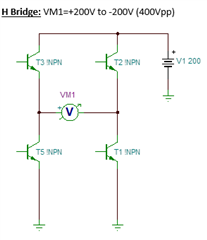Other Parts Discussed in Thread: UCC21551
Tool/software:
Dear all,
I must develop an AC high voltage function generator with maximum 600Vrms @ 400Hz, i.e. 1700Vpp sine, with a 3Mohm load (0.2mArms).
I have already a programmable DC voltage source up to 2kV and max. 2mA.
The best way to do that I think is to generate the output signal with a Mosfet push-pull stage, and a PWM signal from our CPU to make the sine wave.
I’m looking for an isolated dual channel Mosfet gate driver with those properties:
- 1700V channel-to channel isolation
- Max. 1mA Ivdd secondary current (supply), that I have some margin for the load current.
- 100kHz PWM
I was looking at drivers like the UCC21550, 21551, 21540, etc… But all of them need about 3mA on VDD, which overloads my HV DC generator.
Unfortunately there is no parameter filter on the TI website for quiescent current and for channel-to-channel isolation, it makes the research difficult.
Do you have something which fits?
Thank you, best regards.




